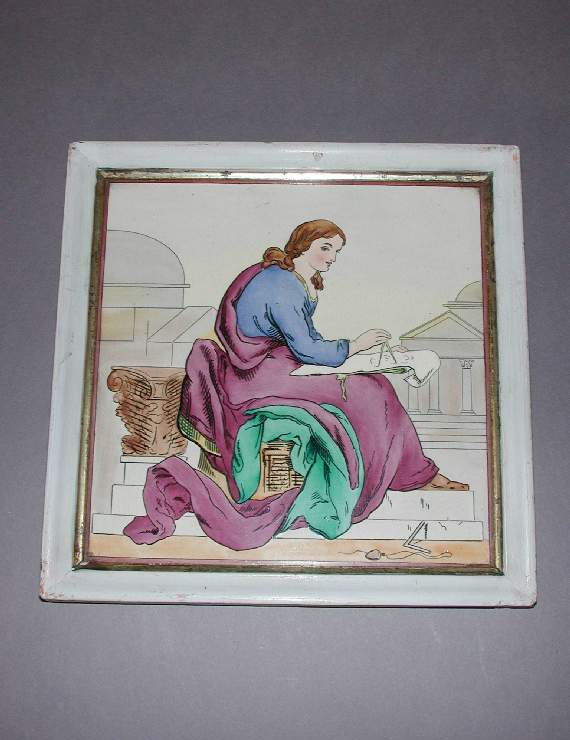Current Location: Gallery 27 (Glaisher)
Titles
‘Architecture’ tile
Maker(s)
Factory:
Minton Hollins & Co.
unidentified artist
Entities
Categories
Description
Earthenware, transfer-printed, hand-painted and glazed, in painted wood frame
Square, off-white, dust-pressed earthenware tile. Transfer printed design shows an allegorical figure of ‘Architecture’ holding an opened scroll and a pair of dividers, sitting on steps and leaning against a Corinthian capital. In the background are diagrams of two classically-inspired buildings; in the foreground, a set-square and plumb line. The figures and objects are filled with shaded blocks of colour. The woman’s under-shirt is blue, edged with yellow, and covered by a flowing magenta robe with green lining. Her hair, shoes and the capital are brown. The back of the tile is pressed into coffered squares, unglazed.
Notes
History note: Purchased from Mrs Joan Eve, Cambridge
Legal notes
Purchased with the J.R.V. Smyth Fund.
Measurements and weight
Height: 20.5 cm
Width: 20.5 cm
Acquisition and important dates
Method of acquisition: Bought
(1983-06-13)
by
Eve, Joan
Dating
19th Century, Late
Circa
1875
CE
-
1880
CE
Note
Minton, founded in 1793, originally produced blue printed earthenware and, later, creamware, bone china and other products, particularly tableware. From the mid 1830s, new lines in encaustic and printed tiles, figures and ornamental wares were introduced, and in 1844 the factory was commissioned to produce floor tiles to Pugin’s designs for the new Palace of Wedminster. The 1840s also saw the introduction of dust-pressed tiles, made by pressing powdered clay into a moulding box, building on a process patented by Richard Prosser for making buttons. Dust-pressed tiles dry more quickly and are less likely to warp. Moreover, by introducing dies into the moulding box, a single press can produce relief decoration and a moulded back - a characteristic feature of dust-pressed tiles, which aids bonding with mortar. In 1845, Herbert Minton took two nephews, Colin Minton Campbell and Michael Daintry Hollins, into partnership. In 1868, following a dispute, Hollins left to set up a tile works trading as Minton, Hollins & Co., which continued successfully into 1950s, before merging with Johnson tiles. Mintons also continues to produce tiles.
This tile is one of a series of allegorical figures representing The Arts. Three are in the Fitzwilliam Collection: ‘Sculpture’, ‘Design’ and ‘Architecture’, there may also have been others, perhaps including ‘Music’. The series was also produced in 6 inch tiles. These three tiles may originally have been displayed as plaques or inset as panels into a cabinet or washstand. The series is linked by a unified colour-scheme, similarly drawn and clothed figures and recurring attributes. The allegorical theme and dress are classical, but the setting, pose and bold colours give the tiles a more modern air. Although examples of this design are rare, tile series were popular at the time, with subjects ranging from ‘agriculture’ to ‘musical instruments’; another version of Arts and Sciences, designed by John Moyr Smith for Mintons China Works in c.1892, shows more classically posed figures.
School or Style
Victorian
People, subjects and objects depicted
Components of the work
Decoration
composed of
enamels
( green, magenta and brown)
Materials used in production
Earthenware
Techniques used in production
Dust-pressing
: Dust-pressed earthenware moulded on one side, transfer-printed and hand-painted
Transfer-printing
Painting
Inscription or legends present
Inscription present: (probably - obscured by newspaper backing, but on others in this series)
- Text: MINTON / HOLLINS / & Co; / PATENT / TILE / WORKS / STOKE ON / TRENT
- Method of creation: Relief moulded
- Type: Mark
References and bibliographic entries
Identification numbers
Accession number: C.15-1983
Primary reference Number: 15309
Stable URI
Audit data
Created: Saturday 6 August 2011
Updated: Tuesday 30 April 2024
Last processed: Wednesday 14 May 2025
Associated departments & institutions
Owner or interested party:
The Fitzwilliam Museum
Associated department:
Applied Arts




